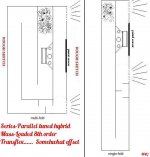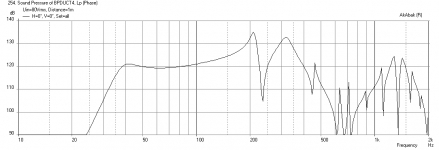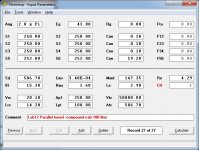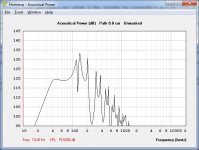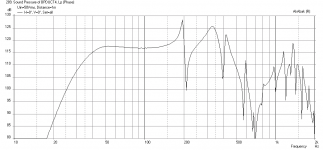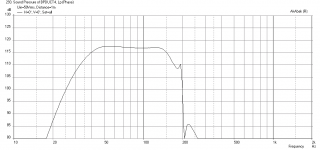Beau,
RIGHT ON ! You should not be disappointed ! 😀
The replacement Makita track saw should arrive mid next week (the first one had a crack in the enclosure). Sometime after that - the fun begins.
So, two Lab 15s, two 2512 (each, 2 ft^3) sealed, each topped by an Anarchy/RS28 two way.
Happy New Year to all of the fine folks on DIYaudio !
I have been immersed in a tweeter array project for the last week which i am finally satisfied with , It is two 4 element piezo line arrays driven by a crossover and step-up transformer (per array) .... The drivers are "FrankenPiezos" which are a great discovery by Mr Brian Steele here on DIYaudio.. He figured out that if you take the Piezo element from a GRS brand 1016 and stick it onto a Goldwood brand 1016 horn body amazing things happen =) Surprisingly flattish high fidelity response from a piezo ..... Stuffing the rear chamber (i used dryer lint) is also recommended to smooth things out further ... I even went ahead and damped the back of cheap plastic horns with caulking to reduce resonances and coloration ...
I don't think anyone has used Brian's Frankenpiezos in an array before (if someone has then they haven't posted it that i know of), but let me tell you that they do work in an array ! In fact , they REALLY work 😱 ... Unlike the Goldwood piezo benders which have problems with inconsistent phase response (especially above 10k between units) these GRS elements are far superior , more coherent in regards to phase response and therefore work better in arrays because they aren't fighting each other (on axis) , instead they just properly complement each other throughout the working range ... The result is loud and smooth with excellent vertical pattern control of course =) ...........None of that fatiguing harsh 4k-5k "honk" & "shout"... The extension also goes lower than a standard GW 1016 array .......
Very little EQing required , in fact i was able to get away with no eqing
...... They integrated very well with my Electrovoice midrange horns (similar to something like a BFM OT12 but with 10" driver).. The EVs play up to about 2.5-3k range which meets the lower knee of the Frankens perfectly .....
The BFM guys should really check out the FrankenPiezos since they utilize Piezo arrays on so many of Bill's model's ... I would be curious to see how one of Bill's "melded arrays" made out of these things could work out ....😀
..........................................................
ANYWAY, back to subwoofers, i have been working on simming a few different boxes for Palsa's Lab12s , will post about those here in a bit ....
I have been immersed in a tweeter array project for the last week which i am finally satisfied with , It is two 4 element piezo line arrays driven by a crossover and step-up transformer (per array) .... The drivers are "FrankenPiezos" which are a great discovery by Mr Brian Steele here on DIYaudio.. He figured out that if you take the Piezo element from a GRS brand 1016 and stick it onto a Goldwood brand 1016 horn body amazing things happen =) Surprisingly flattish high fidelity response from a piezo ..... Stuffing the rear chamber (i used dryer lint) is also recommended to smooth things out further ... I even went ahead and damped the back of cheap plastic horns with caulking to reduce resonances and coloration ...
I don't think anyone has used Brian's Frankenpiezos in an array before (if someone has then they haven't posted it that i know of), but let me tell you that they do work in an array ! In fact , they REALLY work 😱 ... Unlike the Goldwood piezo benders which have problems with inconsistent phase response (especially above 10k between units) these GRS elements are far superior , more coherent in regards to phase response and therefore work better in arrays because they aren't fighting each other (on axis) , instead they just properly complement each other throughout the working range ... The result is loud and smooth with excellent vertical pattern control of course =) ...........None of that fatiguing harsh 4k-5k "honk" & "shout"... The extension also goes lower than a standard GW 1016 array .......
Very little EQing required , in fact i was able to get away with no eqing
...... They integrated very well with my Electrovoice midrange horns (similar to something like a BFM OT12 but with 10" driver).. The EVs play up to about 2.5-3k range which meets the lower knee of the Frankens perfectly .....
The BFM guys should really check out the FrankenPiezos since they utilize Piezo arrays on so many of Bill's model's ... I would be curious to see how one of Bill's "melded arrays" made out of these things could work out ....😀
..........................................................
ANYWAY, back to subwoofers, i have been working on simming a few different boxes for Palsa's Lab12s , will post about those here in a bit ....
ANYWAY, back to subwoofers, i have been working on simming a few different boxes for Palsa's Lab12s , will post about those here in a bit ....
Thank you very much for your work over the holidays! happy new years to all!
The LAB12 has such a strong cone, it seems unjust to use in my reflex application =( Lets give it some compression ratio!!
Thank you very much for your work over the holidays! happy new years to all!
The LAB12 has such a strong cone, it seems unjust to use in my reflex application =( Lets give it some compression ratio!!
Oh yeah, that cone can take some abuse for sure ... If i remember correctly that was one of the drivers that held up well in Weltersys's Keystone so it could be something for you to look into .....
For these other transflex/tapped designs we may not be able to get a lot of compression at 35hz tune in a 100 liter box without moving the lower knee upward too much , the t/s params for that driver may not allow for such a thing in a small TH box, but i did tinker around with it quite a bit in sim and what i get is lots of design options really .....
That lab looks decent enough in a 35hz TH (you can find examples of such a thing here on DIYaudio) ... You get about 120db that way before running out of excursion in a 100L TH ... Putting that driver in a ML-Transflex gets close to the same and can be made a little smaller ..... If you wanted to go even smaller i think you could make it happen in a 70 liter offset-ML-Transflex but it is definitely a few DBs down from the 100L TH (to be expected) , yet still better than a bass reflex box ..... So nothing is really surprising so far EXCEPT for an experimental 8th-order-ML-transflex design which does beat out the TH by a bit , but it is also slightly larger ................ Interestingly enough the same experimental design tuned to 40hz gets about 125db with two Alpine SWE-10S4s in a package not much larger than 100 liter! Now that is kind of exciting.... Tuned down to 35hz it should be closely competitive with the Lab15 special box, with a little less money spent on drivers ...
🙂
M
Last edited:
Something useful?
Now here is something that Karlson fans (GM, XRK , Freddi?) might already know but i feel like it is worth mentioning because i think it may lead to a new configuration for me ...... I had an epiphany the other day about some of these Karlson cabs, they are not just 8th order but also a sort of hybrid mix of series-tuned and parallel tuned, in a way it is really BOTH simultaneously and i am now just beginning to understand how special and useful that can be
...... I had an epiphany the other day about some of these Karlson cabs, they are not just 8th order but also a sort of hybrid mix of series-tuned and parallel tuned, in a way it is really BOTH simultaneously and i am now just beginning to understand how special and useful that can be  .... Via some amount of chamber-sharing i can reduce the size of one of these 8th order boxes without losing any performance ...... Unfortunately HR cannot fully simulate such a beast, but i can and have come up with equivalent simulations that suffice except for one aspect of it that will determine where exactly the FB will land ..... Luckily , adjusting the size of the FIRST of two mouths will effectively shift the fundamental, and that can be done easily enough after the box is built ......
.... Via some amount of chamber-sharing i can reduce the size of one of these 8th order boxes without losing any performance ...... Unfortunately HR cannot fully simulate such a beast, but i can and have come up with equivalent simulations that suffice except for one aspect of it that will determine where exactly the FB will land ..... Luckily , adjusting the size of the FIRST of two mouths will effectively shift the fundamental, and that can be done easily enough after the box is built ......
I will post a rough sketch so you guys can see what i am talking about .... It is very similar to other 8th order designs i had posted here previously with the only difference being that the small pipe-chamber has both ends open instead of only one, this creates some amount of sharing (of the small pipe chamber) extending the effective path length of the box a little bit, and this is how i get the size reduction in order to get the same target fundamental ................. With the small pipe-chamber having both ends open it also raises the small chamber's resonance significantly because it will be operating more along the lines of a halfwave (like two quarterwaves placed end to end, instead of a plain ole quarterwave) raising the upper bandpass cutoff .... There might possibly be some helmholtz resonance action too, but i have to think this through a little more and possibly do some testing to be sure because right now with the small chamber that i am contemplating (30-ish liter , 60cm length , open at both ends) i am getting a helmholtz resonance well below 200hz and a halfwave resonance well above 200hz ...?.... hmmm ... curious ..
I realize i am stepping way off the beaten path here, but i think i might be onto something..😀
...............................................................................................................................
one of these things is not like the other










Now here is something that Karlson fans (GM, XRK , Freddi?) might already know but i feel like it is worth mentioning because i think it may lead to a new configuration for me
 ...... I had an epiphany the other day about some of these Karlson cabs, they are not just 8th order but also a sort of hybrid mix of series-tuned and parallel tuned, in a way it is really BOTH simultaneously and i am now just beginning to understand how special and useful that can be
...... I had an epiphany the other day about some of these Karlson cabs, they are not just 8th order but also a sort of hybrid mix of series-tuned and parallel tuned, in a way it is really BOTH simultaneously and i am now just beginning to understand how special and useful that can be  .... Via some amount of chamber-sharing i can reduce the size of one of these 8th order boxes without losing any performance ...... Unfortunately HR cannot fully simulate such a beast, but i can and have come up with equivalent simulations that suffice except for one aspect of it that will determine where exactly the FB will land ..... Luckily , adjusting the size of the FIRST of two mouths will effectively shift the fundamental, and that can be done easily enough after the box is built ......
.... Via some amount of chamber-sharing i can reduce the size of one of these 8th order boxes without losing any performance ...... Unfortunately HR cannot fully simulate such a beast, but i can and have come up with equivalent simulations that suffice except for one aspect of it that will determine where exactly the FB will land ..... Luckily , adjusting the size of the FIRST of two mouths will effectively shift the fundamental, and that can be done easily enough after the box is built ......I will post a rough sketch so you guys can see what i am talking about .... It is very similar to other 8th order designs i had posted here previously with the only difference being that the small pipe-chamber has both ends open instead of only one, this creates some amount of sharing (of the small pipe chamber) extending the effective path length of the box a little bit, and this is how i get the size reduction in order to get the same target fundamental ................. With the small pipe-chamber having both ends open it also raises the small chamber's resonance significantly because it will be operating more along the lines of a halfwave (like two quarterwaves placed end to end, instead of a plain ole quarterwave) raising the upper bandpass cutoff .... There might possibly be some helmholtz resonance action too, but i have to think this through a little more and possibly do some testing to be sure because right now with the small chamber that i am contemplating (30-ish liter , 60cm length , open at both ends) i am getting a helmholtz resonance well below 200hz and a halfwave resonance well above 200hz ...?.... hmmm ... curious ..

I realize i am stepping way off the beaten path here, but i think i might be onto something..😀
...............................................................................................................................
one of these things is not like the other










Attachments
Last edited:
Oh yeah, that cone can take some abuse for sure ... If i remember correctly that was one of the drivers that held up well in Weltersys's Keystone so it could be something for you to look into .....
For these other transflex/tapped designs we may not be able to get a lot of compression at 35hz tune in a 100 liter box without moving the lower knee upward too much , the t/s params for that driver may not allow for such a thing in a small TH box, but i did tinker around with it quite a bit in sim and what i get is lots of design options really .....
That lab looks decent enough in a 35hz TH (you can find examples of such a thing here on DIYaudio) ... You get about 120db that way before running out of excursion in a 100L TH ... Putting that driver in a ML-Transflex gets close to the same and can be made a little smaller ..... If you wanted to go even smaller i think you could make it happen in a 70 liter offset-ML-Transflex but it is definitely a few DBs down from the 100L TH (to be expected) , yet still better than a bass reflex box ..... So nothing is really surprising so far EXCEPT for an experimental 8th-order-ML-transflex design which does beat out the TH by a bit , but it is also slightly larger ................ Interestingly enough the same experimental design tuned to 40hz gets about 125db with two Alpine SWE-10S4s in a package not much larger than 100 liter! Now that is kind of exciting.... Tuned down to 35hz it should be closely competitive with the Lab15 special box, with a little less money spent on drivers ...
🙂
M
That box from the next post looks interesting! I have no idea how you're coming up with these haha
Regarding the LAB12 Box, I'm having trouble getting inputs into HR. I think what I'm looking to do of possible is to expand the first Alpine SWE-10S4 box large enough to work with the LAB12.
Did you happen to have the inputs and layouts for the ML-transflex or tapped horn designs you mentioned? I don't mean to keep asking but I still am not proficient at HR to translate those inputs to a design unfortunately.
Thanks for the help!
Hi
I have 8pc LAB12 and even 2pc bc 12tbx100. For a long time looking for the right baffle. It is mainly about me 12tbx100. Someone help me with a proposal for transflex 12tbx100 ?. I tried hornresp, but I can not with him.
PS: Sorry for my English. Google Translate 🙂
I have 8pc LAB12 and even 2pc bc 12tbx100. For a long time looking for the right baffle. It is mainly about me 12tbx100. Someone help me with a proposal for transflex 12tbx100 ?. I tried hornresp, but I can not with him.
PS: Sorry for my English. Google Translate 🙂
Palsa and Luuker ,
I haven't made any sketches or layouts for a Lab12 cabinet just yet, at least not anything with any detail ..... I was waiting to find a sim that i felt worked exceptionally well for this driver (other than the 8th order experimental beast above)...
Then today i think i found an ML-Transflex configuration tuned to 35hz that looks fantastic using the Lab12 , as long as you don't need bandwidth that extends above 100hz .......
i think i found an ML-Transflex configuration tuned to 35hz that looks fantastic using the Lab12 , as long as you don't need bandwidth that extends above 100hz .......
Moving the constriction (port) further up the path is the change i made in order to optimally accommodate the Lab12 ..... The port is only a few feet down from the closed end of the pipe now (notice VTC and ATC values).... ....
Has great output for an extremely simple 110 liter box with a single driver! 😀 (however two 10S4s still do better in about the same size box, but thats two drivers not one, and this is tuned lower)
The outer dimensions seem reasonable on this tower shaped cabinet at around 43" H x 13.5" W x 14.5" D (subject to updates at this point) .....
I have already begun working on a sketch ..... In the meantime go ahead and load these Hornresponse inputs into your software to see if you like the way it performs .....
I haven't made any sketches or layouts for a Lab12 cabinet just yet, at least not anything with any detail ..... I was waiting to find a sim that i felt worked exceptionally well for this driver (other than the 8th order experimental beast above)...
Then today
 i think i found an ML-Transflex configuration tuned to 35hz that looks fantastic using the Lab12 , as long as you don't need bandwidth that extends above 100hz .......
i think i found an ML-Transflex configuration tuned to 35hz that looks fantastic using the Lab12 , as long as you don't need bandwidth that extends above 100hz .......Moving the constriction (port) further up the path is the change i made in order to optimally accommodate the Lab12 ..... The port is only a few feet down from the closed end of the pipe now (notice VTC and ATC values).... ....
Has great output for an extremely simple 110 liter box with a single driver! 😀 (however two 10S4s still do better in about the same size box, but thats two drivers not one, and this is tuned lower)
The outer dimensions seem reasonable on this tower shaped cabinet at around 43" H x 13.5" W x 14.5" D (subject to updates at this point) .....
I have already begun working on a sketch ..... In the meantime go ahead and load these Hornresponse inputs into your software to see if you like the way it performs .....
Attachments
Last edited:
Simple quasi 6th order bandpass box with 12HP1030
If you use a Faital Pro 12HP1030 driver and make a very simple 33 liter chamber box connected to an 8 liter front chamber with a 14 in x 1.75 in x 30 in long wrap-around channel vent, and an 8 in dia round exit aperture (thru 0.75in ply) on the front chamber, you end up with a compact 53 liter (1.87 cu ft) box (including vent volume) that can produce 120 dB output (2 pi half-space) when driven to xmax of 12.5 mm at 80 volts. The benefit of wider bandwidth is possible with a small front chamber. The front chamber provides exceptional cone motion control that allows 80 volts of drive. A 34Hz 24dB/oct HPF was used here to prevent over-excursion at lower frequencies.
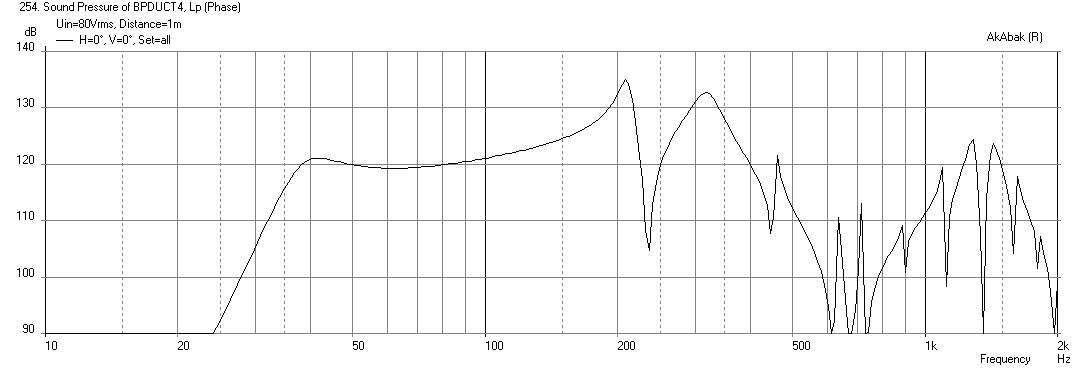
If you use a Faital Pro 12HP1030 driver and make a very simple 33 liter chamber box connected to an 8 liter front chamber with a 14 in x 1.75 in x 30 in long wrap-around channel vent, and an 8 in dia round exit aperture (thru 0.75in ply) on the front chamber, you end up with a compact 53 liter (1.87 cu ft) box (including vent volume) that can produce 120 dB output (2 pi half-space) when driven to xmax of 12.5 mm at 80 volts. The benefit of wider bandwidth is possible with a small front chamber. The front chamber provides exceptional cone motion control that allows 80 volts of drive. A 34Hz 24dB/oct HPF was used here to prevent over-excursion at lower frequencies.

Attachments
Last edited:
If you use a Faital Pro 12HP1030 driver and make a very simple 33 liter chamber box connected to an 8 liter front chamber with a 14 in x 1.75 in x 30 in long wrap-around channel vent, and an 8 in dia round exit aperture (thru 0.75in ply) on the front chamber, you end up with a compact 53 liter (1.87 cu ft) box (including vent volume) that can produce 120 dB output (2 pi half-space) when driven to xmax of 12.5 mm at 80 volts. The benefit of wider bandwidth is possible with a small front chamber. The front chamber provides exceptional cone motion control that allows 80 volts of drive. A 34Hz 24dB/oct HPF was used here to prevent over-excursion at lower frequencies.
Xrk,
That simulates incredibly well ! Has anyone built that yet? It would be great to know how much that small chamber helps to control excursion ... Out of curiosity ever try plugging a Lab12 into that sim? It seems that a bunch of the DIY folks have the labs and are itching to do something interesting with them ....
I have tinkered with the addition of small chambers to make parallel 6th order boxes in sim before, sometimes it works out really well .... Hornresponse allows it in a few different ways ...
I just made a sim with the Lab12 in a Parallel tuned 6th order with a very small front chamber using Hornresponse's Compound Horn mode ......It is using mainly the throat chamber and rear chambers in sim..... Doesn't look too bad , with some stuffing in the right place that upper bandwidth could be useful 🙂
Yet, not nearly as compact as your Faital Pro box ....
Attachments
Last edited:
Thank you MMJ! I could probably work from those now that I think about it.
XRK that looks like a truly amazing cab! Thanks to the LAB12's *phenomenal* heat dissipation abilities (jokes) I could probably only feed it 300 watts of sine wave based music before it underwent some major power compression and spontaneous combustion potentially.
From what I've seen most LAB12 loaded cabs have a huge peak a some frequency followed by a deep trough... Is that low Fs?
Has it ever been run through that akabak sim? I would really rather not buy another driver and let the LAB12 go to waste. I understand a large loss in output will result from cutting the power by that much but that box outperforms my current one by a lot for it's size.
What is this technique of a small front chamber for excursion control called? Does that make it a bandpass?
Sent from my iPhone using Tapatalk
XRK that looks like a truly amazing cab! Thanks to the LAB12's *phenomenal* heat dissipation abilities (jokes) I could probably only feed it 300 watts of sine wave based music before it underwent some major power compression and spontaneous combustion potentially.
From what I've seen most LAB12 loaded cabs have a huge peak a some frequency followed by a deep trough... Is that low Fs?
Has it ever been run through that akabak sim? I would really rather not buy another driver and let the LAB12 go to waste. I understand a large loss in output will result from cutting the power by that much but that box outperforms my current one by a lot for it's size.
What is this technique of a small front chamber for excursion control called? Does that make it a bandpass?
Sent from my iPhone using Tapatalk
Last edited:
Lab12 in 6th order 2.08 cu ft bandpass box
Yes, adding a front chamber with the reflex vent passing through the front chamber makes it a bandpass since above a certain frequency, the rear wave cancels the front wave and you have a sharp falloff. In this case the alignment is called a 6th order bandpass. Making the front chamber smaller increases the high frequency bandwidth and helps to reduce cone motion.
The Lab12 is not a bad performer in a 6th order bandpass box. It has a larger Vas and Qts, and is lower in sensitivity than the 12HP1030 but looks quite decent for a 2.08 cu ft enclosure: 117 dB SPL with -3dB at 38Hz. This is at 50 volts drive to hit 13mm xmax so it is fine for music program but not sustained sine waves as it is about 500 watts (100 above rms rating).
The design ended up at 38 liters for the rear chamber, connected to an 8 liter front chamber with a 1.6 in x 14.0 in x 34 in long wrap around channel duct, and an 8in dia exit aperture on the front chamber. Quite easy to make in my opinion, but will need bracing due to extreme pressures generated. You have to ask yourself if it is worth having two units and twice the volume to achieve the same performance as same smaller box with 12HP1030. That driver costs 2x so maybe a wash. If you have a couple of Lab12's already then it's a no brainer to make it with the Labs.
Here is the predicted performance in 2pi space with 50 volts drive and a 27Hz -24dB/oct HPF:
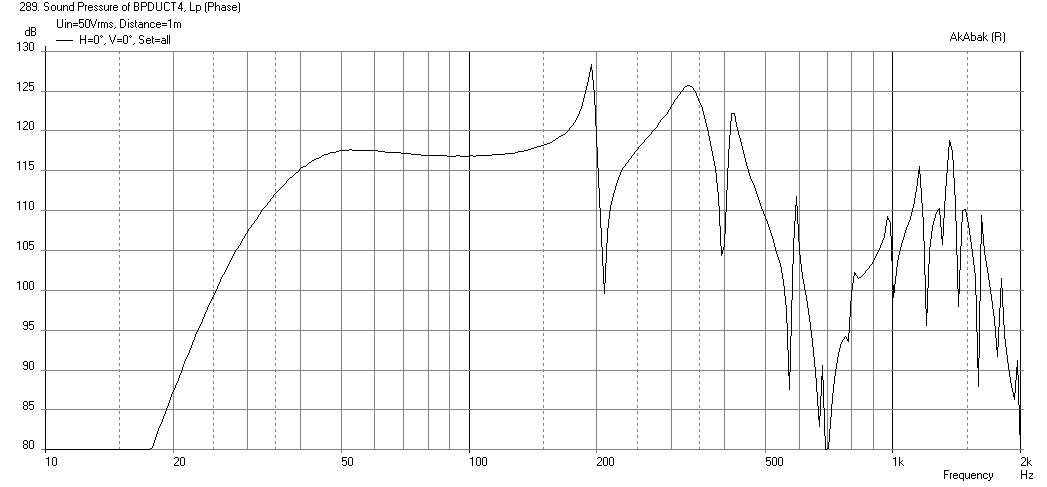
Here is the predicted performance with a -48dB/oct LPF at 150Hz included:
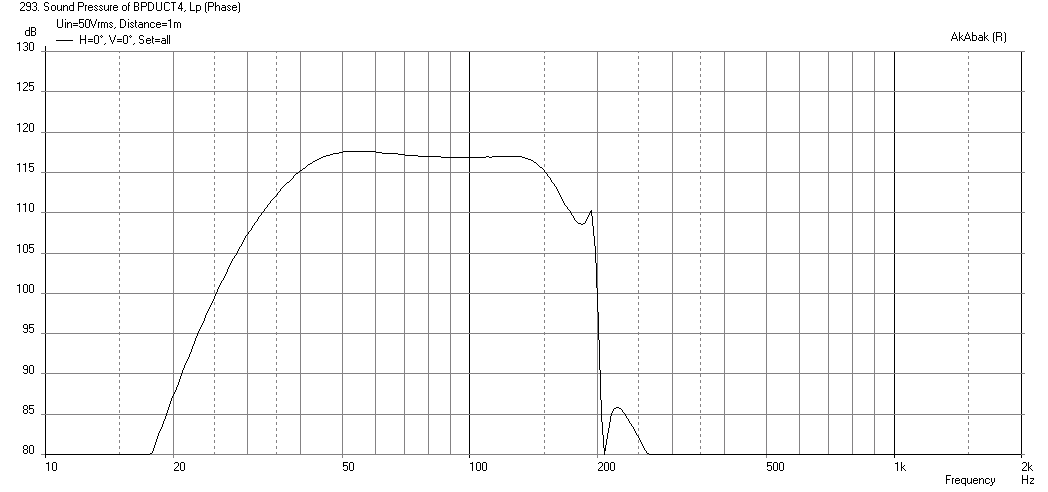
In case anyone is wondering if there will be problems with chuffing due to high vent or exit duct velocities, they are all within good reasonable limits as shown below:

Seems like a very compact 117dB setup if you ask me...
If Tb46 has the time, I am sure he can provide some nice drawings for those who can't figure out the design based on my written description. 🙂
Has it ever been run through that akabak sim? I would really rather not buy another driver and let the LAB12 go to waste. I understand a large loss in output will result from cutting the power by that much but that box outperforms my current one by a lot for it's size.
What is this technique of a small front chamber for excursion control called? Does that make it a bandpass?
Yes, adding a front chamber with the reflex vent passing through the front chamber makes it a bandpass since above a certain frequency, the rear wave cancels the front wave and you have a sharp falloff. In this case the alignment is called a 6th order bandpass. Making the front chamber smaller increases the high frequency bandwidth and helps to reduce cone motion.
The Lab12 is not a bad performer in a 6th order bandpass box. It has a larger Vas and Qts, and is lower in sensitivity than the 12HP1030 but looks quite decent for a 2.08 cu ft enclosure: 117 dB SPL with -3dB at 38Hz. This is at 50 volts drive to hit 13mm xmax so it is fine for music program but not sustained sine waves as it is about 500 watts (100 above rms rating).
The design ended up at 38 liters for the rear chamber, connected to an 8 liter front chamber with a 1.6 in x 14.0 in x 34 in long wrap around channel duct, and an 8in dia exit aperture on the front chamber. Quite easy to make in my opinion, but will need bracing due to extreme pressures generated. You have to ask yourself if it is worth having two units and twice the volume to achieve the same performance as same smaller box with 12HP1030. That driver costs 2x so maybe a wash. If you have a couple of Lab12's already then it's a no brainer to make it with the Labs.
Here is the predicted performance in 2pi space with 50 volts drive and a 27Hz -24dB/oct HPF:

Here is the predicted performance with a -48dB/oct LPF at 150Hz included:

In case anyone is wondering if there will be problems with chuffing due to high vent or exit duct velocities, they are all within good reasonable limits as shown below:

Seems like a very compact 117dB setup if you ask me...
If Tb46 has the time, I am sure he can provide some nice drawings for those who can't figure out the design based on my written description. 🙂
Attachments
Last edited:
Hi xrk971,
Sorry, too many things going on at work. 🙂 Probably, one of your hand sketches would be all anyone should need.
By the way, WinISD_v0.7 will do what they call an ABC alignment, as well as the normal BP4 and BP6 alignments. Here is an example from the PE techtalk:
ABC Bookshelf Speakers
I found the download link for WinISD_v0.7 on their facebook site:
https://www.facebook.com/WinISD
One more link:
http://www.diysubwoofers.org/prt/dual_chamber.htm
Regards,
Sorry, too many things going on at work. 🙂 Probably, one of your hand sketches would be all anyone should need.
By the way, WinISD_v0.7 will do what they call an ABC alignment, as well as the normal BP4 and BP6 alignments. Here is an example from the PE techtalk:
ABC Bookshelf Speakers
I found the download link for WinISD_v0.7 on their facebook site:
https://www.facebook.com/WinISD
One more link:
http://www.diysubwoofers.org/prt/dual_chamber.htm
Regards,
Last edited:
Thank you MMJ! I could probably work from those now that I think about it.
You are welcome!🙂
How many of these Lab12 drivers do you have?
From what I've seen most LAB12 loaded cabs have a huge peak a some frequency followed by a deep trough... Is that low Fs?
FS is just the free-air resonance value of the driver ... This value happens to be very low for your Lab12 , more suited to very low tuned cabinets (unless there is a small sealed chamber involved) but they can still be made to work ..... For the cabinets that we have been discussing here like quarter wave tuned & tapped pipe boxes & similar such designs a higher FS that meets or even exceeds FB (by up to a factor of 1.6-ish) is considered more ideal ...
What is this technique of a small front chamber for excursion control called? Does that make it a bandpass?
Yep , it is a bandpass , but so is almost every other box that we have discussed here ... Tapped Horns , Tapped Pipes , Karlsons , Karlsonators , ML-Transflex 6th and 8th orders , PPSLs, Cubos , EV's Manifold Horn design, etc etc etc ..... Technically all of these boxes listed are just creative and clever variations of bandpass boxes .... 😉
Sent from my iPhone using Tapatalk[/QUOTE]
Hi xrk971,
By the way, WinISD_v0.7 will do what they call an ABC alignment, as well as the normal BP4 and BP6 alignments. Here is an example from the PE techtalk:
ABC Bookshelf Speakers
I found the download link for WinISD_v0.7 on their facebook site:
https://www.facebook.com/WinISD
One more link:
The Subwoofer DIY Page - Dual-chamber ported systems
Regards,
Xrk , I have been experimenting with ABC/DCR designs using WinISD version .60a1 ...... I think .7 no longer has the "ABC" feature as they call it , but if i am wrong about that then i should update! (because .60a1 does have a few bugs) ...... However, If anyone wants this old version of WinISD just let me know , i can post it here ...
DCR designs are extremely interesting things ..... I have been trying to think about ways to work a DCR feature into some of the bandpass designs we have been working on , it is tricky though......
Maybe i will try to load that Lab12 into WinISD .60a1 to see if it looks good in a classic DCR cabinet ...
Seems like a very compact 117dB setup if you ask me...
If Tb46 has the time, I am sure he can provide some nice drawings for those who can't figure out the design based on my written description. 🙂
Thank you very much for simming that!
I have the latest WinISD off of Facebook and I'm always playing around with it!
It seems like an easy cab to build indeed. I often use Solidworks to model the cab and check for volume as I go. Thankfully eminence also includes driver volume displaced on their spec sheet. I will model and post a picture for those interested! This seems like an awesome performer for it's size. My issue isn't in total output but rather making the best of my current driver and pack space. Since I fully plan on building 2 of MMJ's "LAB15 special" cabs for full PA duty, I still want a smaller cab for smaller gatherings since pack space is at a minimum for me. This bandpass box looks like it'll outperform my reflex by a few more dB and remain the same size if not smaller.
The only thing I'm fuzzy on is the 8" exit aperture. Is this 8" hole cut in the wrap around port wall towards it's end?
Thanks again!
EDIT* now that I realize a 6th order bandpass has 2 ports it makes more sense what to do. The 3/4" of ply acts as the correct port length?
Sent from my iPhone using Tapatalk
Last edited:
[/QUOTE]You are welcome!🙂
How many of these Lab12 drivers do you have?
FS is just the free-air resonance value of the driver ... This value happens to be very low for your Lab12 , more suited to very low tuned cabinets (unless there is a small sealed chamber involved) but they can still be made to work ..... For the cabinets that we have been discussing here like quarter wave tuned & tapped pipe boxes & similar such designs a higher FS that meets or even exceeds FB (by up to a factor of 1.6-ish) is considered more ideal ...
Yep , it is a bandpass , but so is almost every other box that we have discussed here ... Tapped Horns , Tapped Pipes , Karlsons , Karlsonators , ML-Transflex 6th and 8th orders , PPSLs, Cubos , EV's Manifold Horn design, etc etc etc ..... Technically all of these boxes listed are just creative and clever variations of bandpass boxes .... 😉
Sent from my iPhone using Tapatalk
I currently have only 1 LAB12 and unfortunately do not plan on buying more after I figure out what I'm doing with this one!
It seems like xrk's sim of it in a bandpass works great! I need to start researching these here bandpass enclosures. They seem like a cool mix between size efficiency and extension if you can handle the frequency range they put out.
What are the characteristics of these ABC and DCR boxes?
Sent from my iPhone using Tapatalk
What are the characteristics of these ABC and DCR boxes?
Sent from my iPhone using Tapatalk[/QUOTE]
Palsa,
ABC/DCR (DCR is the more appropriate term really) provide two different tuning points ... There is the first box fundamental (fb) which is pretty much like the helmholtz fundamental with a regular bass reflex box (though often shifted down slightly in a DCR , with increased damping) , and then there is a second resonance developed higher up by a parasitic resonator action, usually tuned to be just short of an octave above the fundamental ...
So for example you could set up your DCR box with the Lab12 to simultaneously use 35hz and 60hz tunings ..... It results in tighter control over the cone (compared to Bass Reflex) , and some folks report increased bass output and extension, but it really depends on the T/S parameters of the driver used, not all drivers are well suited for such a design ..
An externally hosted image should be here but it was not working when we last tested it.
Matthew Morgan J :Thank you.
A simulation handled by you for 12tbx100? Not many useful enclosures for the speaker. I need to be minimized and the lower frequency 40Hz.
- Home
- Loudspeakers
- Subwoofers
- New sub design? Constricted Transflex, simple build (series tuned 6th order)
